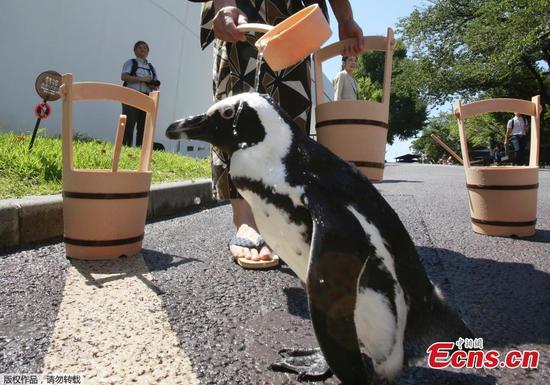
A screen displays countries where China's giant pandas are located worldwide. The display was unveiled at the opening ceremony of the inaugural China Giant Panda International Culture Week in Beijing on Thursday.(Photo/CHINA DAILY)
The search will begin soon for an iconic giant panda image that can represent Chinese culture in international cultural communications and activities.
Designers from home and abroad will first be invited to fully experience giant panda habitats in Sichuan, Shaanxi and Gansu provinces, the China Intercontinental Communication Center said on Thursday at the opening ceremony of the first China Giant Panda International Culture Week in Beijing.

Workers promote the China Giant Panda International Culture Week in Beijing on Thursday. (Photo/CHINA DAILY)
The top 50 entries will be selected before the finals, and the winner is expected to successfully combine Chinese and western art techniques.
"The giant panda, the Great Wall of China and tea are the most popular and iconic Chinese elements in the international community. Pandas rank first according to our survey. They are cute and good-natured 'cultural ambassadors'," said Jing Shuiqing, deputy director of the center.

Visitors take photos at the China Giant Panda International Culture Week in Beijing on Thursday. (Photo/CHINA DAILY)
A China Giant Panda Global Promotional Agreement was signed by the center and the China Conservation and Research Center for the Giant Panda, and an exhibition about pandas from Sichuan began on Thursday and will last until next Sunday.
"As a researcher, I really hope that pandas can go out across the world and bring happiness," said Zhang Zhizhong, Party secretary of the research center.

Visitors take photos at the China Giant Panda International Culture Week in Beijing on Thursday. (Photo/CHINA DAILY)
"The two major challenges the panda population faces are the need to improve genetic diversity and to centralize their habitats. In the future, our goal is to do genetic management and habitat recovery to ensure that more pandas can go out internationally."
In 1982, to protect the species, China stopped giving giant pandas to other countries and instead developed international research cooperation. Pandas sent overseas are supposed to live there for at most 10 years. Their babies will be sent back to China at the age of three, according to the National Forestry and Grassland Administration.

Artists work on panda products at the China Giant Panda International Culture Week in Beijing on Thursday. (Photo/CHINA DAILY)
So far, 58 giant pandas have been involved in international cooperative research projects, and 47 giant panda cubs have been bred abroad, of which 31 have returned to China as required, said Yang Chao, director of the administration's wildlife protection department.

A screen displays stamps of pandas at the China Giant Panda International Culture Week in Beijing on Thursday. (Photo/CHINA DAILY)























